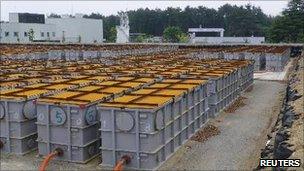Tepco treats radioactive water at Fukushima plant
- Published

Operators of Japan's crippled Fukushima nuclear plant have begun pumping decontaminated water in as part of a system to cool damaged reactors.
The government hailed the move as "a giant step forward" in bringing the facility under control.
Some 110,000 tonnes of water have built up during efforts to cool reactors hit by the 11 March earthquake and tsunami.
The tsunami destroyed both power and back-up generators at the plant, breaking the cooling systems.
Three of the reactors went into meltdown, and there have been radiation leaks.
It is the world's worst nuclear accident since Chernobyl in Ukraine in 1986.
'Critical'
Operator Tokyo Electric Power Company (Tepco) said about 1,850 tonnes of radioactive water had been recycled so far.
The firm said it would continue to inject 16 tonnes of water every hour into reactors 1, 2, and 3, and that 13 tonnes of this would be the decontaminated water.
"This is critical in two aspects," said Goshi Hosono, an adviser to Prime Minister Naoto Kan.
"First, the system will solve the problem of contaminated water, which gave all sorts of worries to the world. Second, it will enable stable cooling of reactors."
Tepco has been running out of space to store the huge quantities of contaminated water, which has also hindered engineers' efforts to carry out critical work.
Small amounts of low-radioactive wastewater have been released into the sea.
Tepco said the process would help the company meet its target of bringing the plant to a "cold shutdown" by January next year.










